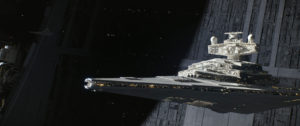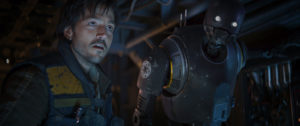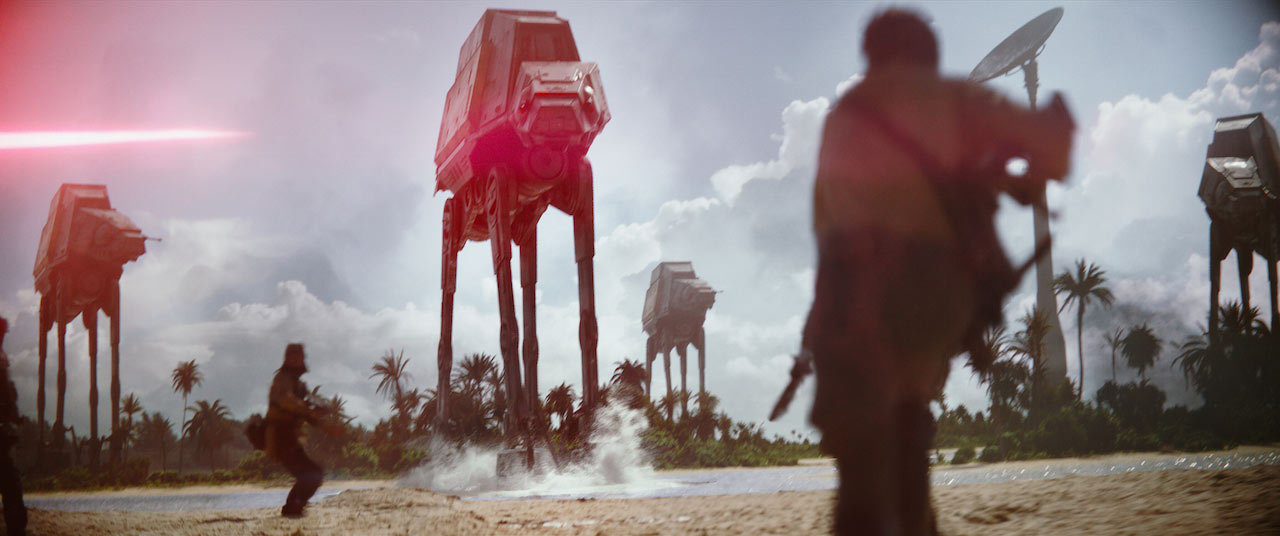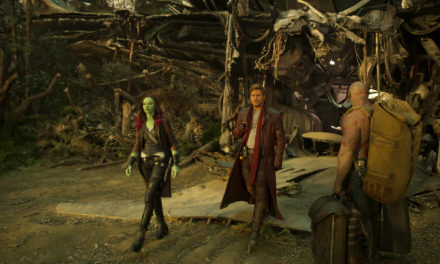By Gavin Arucan | Staff Writer
At long last “Rogue One: A Star Wars Story” brings us a look into the opening crawl of “Star Wars” as we witness just exactly how the Rebellion got its hands on the Empire’s Death Star plans. Unlike last years “Star Wars: The Force Awakens,” “Rogue One” is an anthology film, not a proper episode in the 39-year-old series. It is a standalone film that fills in the gap between “Star Wars Episode III: Revenge of the Sith” and the original “Star Wars.”
While “Star Wars” was a prominent source of entertainment during my childhood, I slowly lost interest for the series during my teenage years until the release of “The Force Awakens.” Since then, I have once again become a “Star Wars” fan, but nowhere near the level that I was as a child, so I was able to go into “Rogue One” with no expectations and a “show me what you’ve got” mentality. I had no reason to be excited for this movie because I knew that some of my favorite “Star Wars” characters like Han Solo and Rey wouldn’t be appearing. There were going to be brand new characters with no existing ties to the “Star Wars” lore, so it was easy for me to remove any unrealistic hype and expectations that might alter my perception of “Rogue One.” Honestly, I think that was a brilliant move on my part because it only heightened by experience as the movie began.
As soon as the iconic text, “A long time ago in a galaxy far, far away,” spread across the screen, a million questions popped into my head. Is there going to be an opening scroll? What’s the music going to be like? What will the very first shot be? Each question only increased my intrigue for the film, and keep in mind that I had no intrigue until those memorable words appeared. I won’t spoil how the movie starts, but the way the beginning was handled, especially with the music, the film declared a powerful statement, through nothing but a couple of words and music, about what these “Star Wars” anthology films were going to bring us.

The Imperial Star Destroyers in “Rogue One” are almost always practical models. (Image courtesy of Lucasfilm)
Before I get into the positives of “Rogue One,” it’s best to mention the bad aspects first, because there’s not much and most of them come out of the first act. Most of the problems I have are nit-picks. Forest Whitaker’s character is mostly useless and has an annoying voice. The character introductions are very rushed. While every character is likable and gets great moments, a few of them don’t get the depth that they deserve. There are a couple of scenes that go a little too distractingly far in trying to reference previous “Star Wars” films. Despite the amazing CGI, one very short, unnecessary scene with a tentacle monster took me out of the film with terrible effects. The biggest problem with “Rogue One” that is not a nit-pick is that even though the characters are likable and the actors are stellar, the characters never really reach the level of brilliance that is Luke, Han, Rey, or Kylo Ren. They’re interesting, but not as interesting as most other “Star Wars” characters.
Comparing “Rogue One” to “The Force Awakens,” “Rogue One” almost never reaches the heights of “The Force Awakens,” but it never quite dips as low as “The Force Awakens” either.
Now, back to the good. The effects are amazing. Even with all of the solid CGI effects, my favorite effects shots are with the Empire’s Star Destroyer ships. I am certain that they are actual, tangible models, and I love a movie that uses practical effects even if it doesn’t need to. Almost every alien character is a puppet or animatronic, and the CGI works well alongside the practical effects to create a universe
that is so quintessentially “Star Wars.” When a filmmaker goes out of his or her way to use practical effects, it gives the film a more passionate human touch than most other action movies.

Cassian Andor (left) provides the charm and K-2SO (right) provides the comedy. (Image courtesy of Lucasfilm)
Some of the standout characters are the hilarious droid, K-2SO; Donnie Yen’s force sensitive and martial arts trained character; and Krennic, the villain who you kind of want to see succeed because he’s constantly being put down by his superiors.
And let’s not forget about the musical score. Surprise! It’s not by John Williams. One of my favorite composers, Michael Giacchino, is the first person who is not John Williams to compose a proper “Star Wars” film. In fact, Giacchino is the first person to compose for every one of Disney’s film divisions. He’s composed some of the best Pixar movies, “Zootopia,” “Tomorrowland,” “Doctor Strange,” and now “Rogue One.” Giacchino’s score takes iconic Williams pieces and adds some twists to them in order to separate the standalone movie from the episodes.
However, nothing I have mentioned even compares to the glorious action scenes in the third act of “Rogue One.” I am confident in saying that “Rogue One” contains the greatest, most epic and most intense third act of any “Star Wars” film. This third act finally puts the “War” in “Star Wars.” I’ve never quite seen action on this level in a “Star Wars” film before. Part of it is due to the set design and cinematography. Everything is so gritty and grounded. Stormtrooper armor is dirty and dented and the explosions and gunfire are treated less like sci-fi special effects and more like a real war film. The audience sees everything from the eyes of the vulnerable people in combat. The AT-ACT’s tower menacingly over the rogue rebels and, for the first time ever, we get to experience being in the line of fire of the Death Star, and it does not disappoint. The space battle is also one the the best. Unlike the emotionless X-Wing fight in “The Force Awakens,” this dogfight harkens back to the original film in which the pilots felt like real people working in a real team.
I don’t think this type of action can ever be replicated in a “Star Wars” episode because “Rogue One,” being a standalone film, actually has stakes. You know that Rey and Finn are going to live through all the battles through “Episode IX” because they’re the main characters in a trilogy. In “Rogue One,” you’re not sure if these new characters are going to make it out alive because there aren’t going to be any sequels. Anything can happen, so it’s actually stressful, suspenseful, and intense.
And, of course, Darth Vader, one of the greatest movie villains of all time, makes and appearance. The few reviews I’ve seen make huge negative statements about the fact that Vader gets very little screen time, but I think that Vader had the perfect amount of scenes. In fact, if the filmmakers cut out the first of his two scenes, I would still be satisfied. I’m not sure why so many people are complaining about the lack of Vader. The movie is called “Rogue One,” not “The Return of Darth Vader.” Vader isn’t connected to the characters of “Rogue One” the way he is to the characters of the original trilogy, so giving him any more scenes would have been unnecessary. His very last scene already steals the whole show, so any more would have ruined it.
“Rogue One” is not a perfect film, but its third act makes up for any of its small flaws. I noticed that a few audience members and many critics deemed the film as “good but not great,” but think it is great. Maybe it’s because those people had unrealistic expectations for the film that tainted their viewing experience, or maybe I’m just riding the enjoyment that the third act gave me and I’m missing all the huge problems in the first two thirds. I think that, over time, I will find more to nit-pick about the characters and find more problems, just as I did with “The Force Awakens” and its sometimes too distracting homages to the original. However, I will always stand by my love for the third act and the overall quality of filmmaking.
“Rogue One” is another strong installment into the “Star Wars” franchise and easily breaks the trend of awful “Star Wars” prequels. I’m definitely going to see it in theaters again and eventually buy it on Blu-ray.






